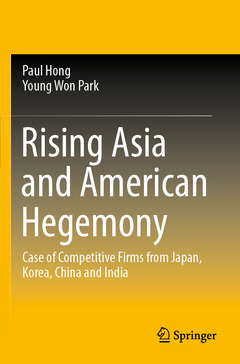Description
Rising Asia and American Hegemony, 1st ed. 2020
Case of Competitive Firms from Japan, Korea, China and India
Authors: Hong Paul, Park Young Won
Language: English
Subjects for Rising Asia and American Hegemony:
Publication date: 08-2021
251 p. · 15.5x23.5 cm · Paperback
Approximative price 137.14 €
In Print (Delivery period: 15 days).
Add to cartPublication date: 02-2020
251 p. · 15.5x23.5 cm · Hardback
Description
/li>Contents
/li>Biography
/li>Comment
/li>
This book provides an overview of evolving patterns of trade partnership with historical perspective. It presents changing requirements of industry competitiveness and explains the vital relationships between trade partnerships and industry competitiveness. As well, it further examines the interactive relationships between trade partnerships and industry competitiveness.
In recent years, with decreasing strategic alliances among nations and less visibility of international governance mechanisms (e.g., WTO) and counter to globalization, preferential trade agreements and free-trade agreements have proliferated among nations. At the same time, industrial competitiveness is becoming a serious strategic policy priority of nations?both advanced and emerging economies.
Theoretical discussion focuses on the practices of global network capabilities for the top of the pyramid (ToP) and base of the pyramid (BoP). Special focus is on trade partnerships and industry competitiveness in the Asian economies (China, Japan, South Korea, India, Indonesia), three ASEAN nations (Vietnam, Thailand, and Malaysia), and Mexico. Extensive industry and firm-level case studies discuss ToP and BoP interface capabilities in the form of manufacturing and services life-cycle management, which extends value creation and delivery of manufacturing and services. This extension integrates the cloud ecosystem, such as timely data/information/knowledge flows via the virtual world; and ground value chains, such as the flow of complex real goods and services in the visible world.



